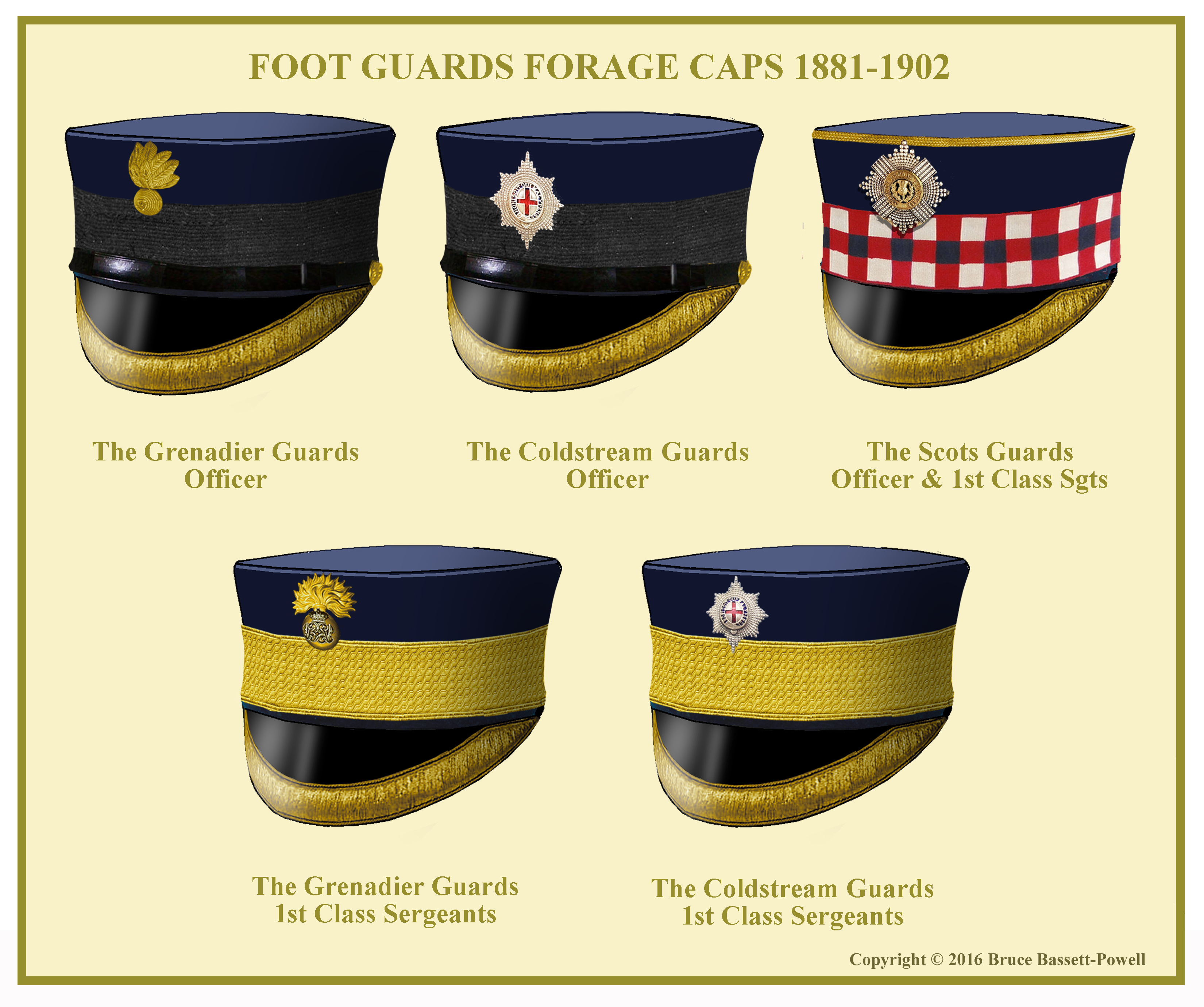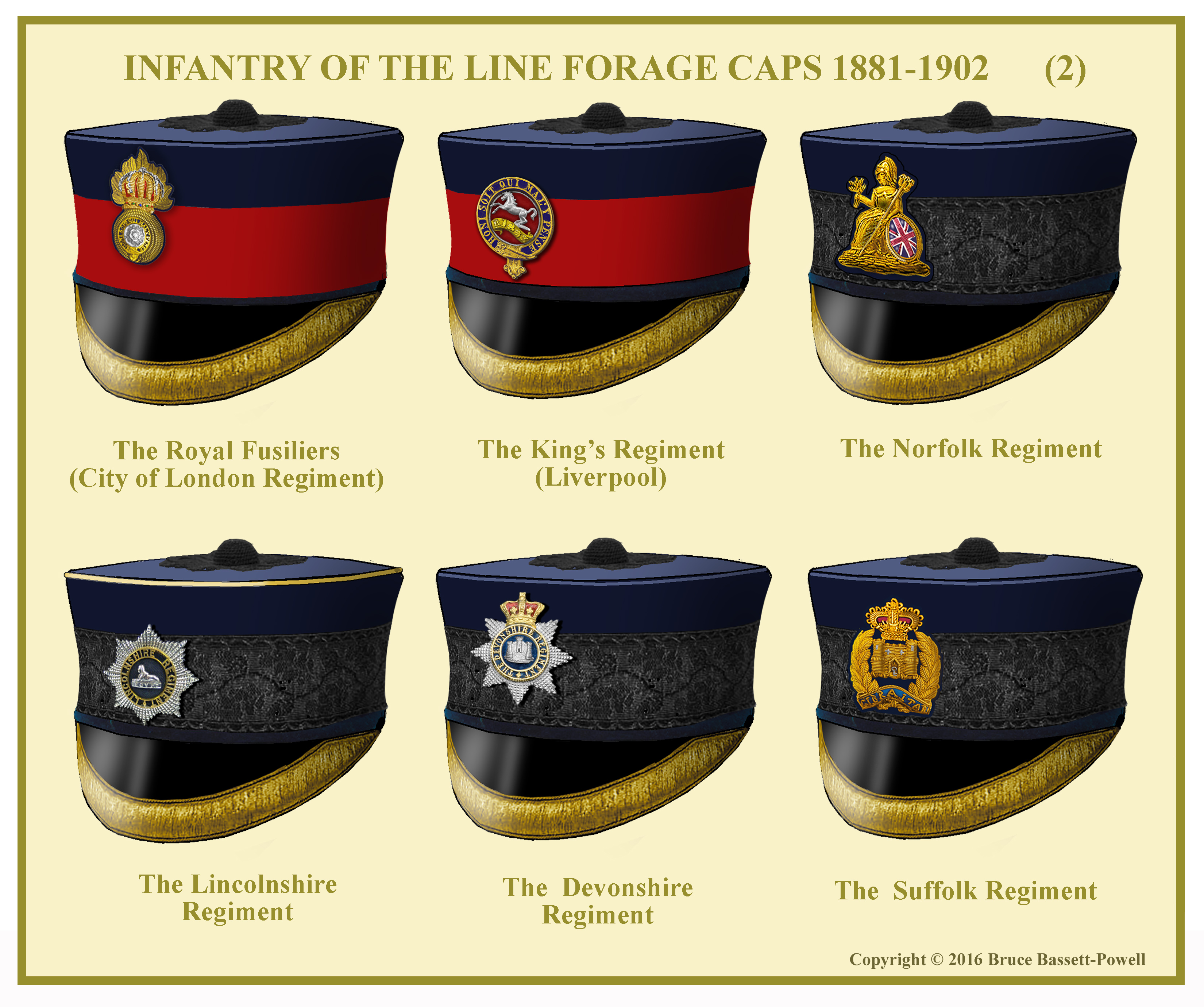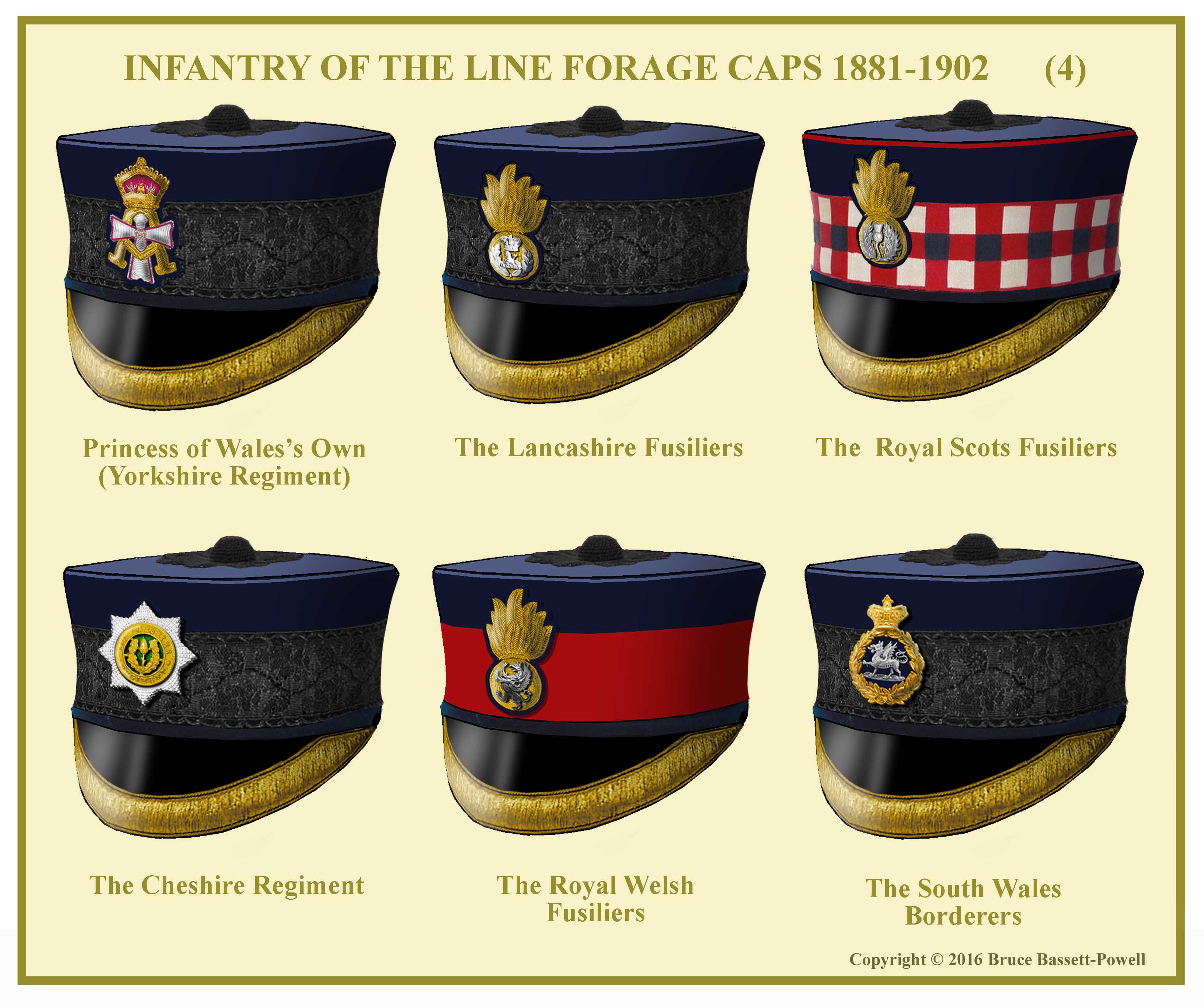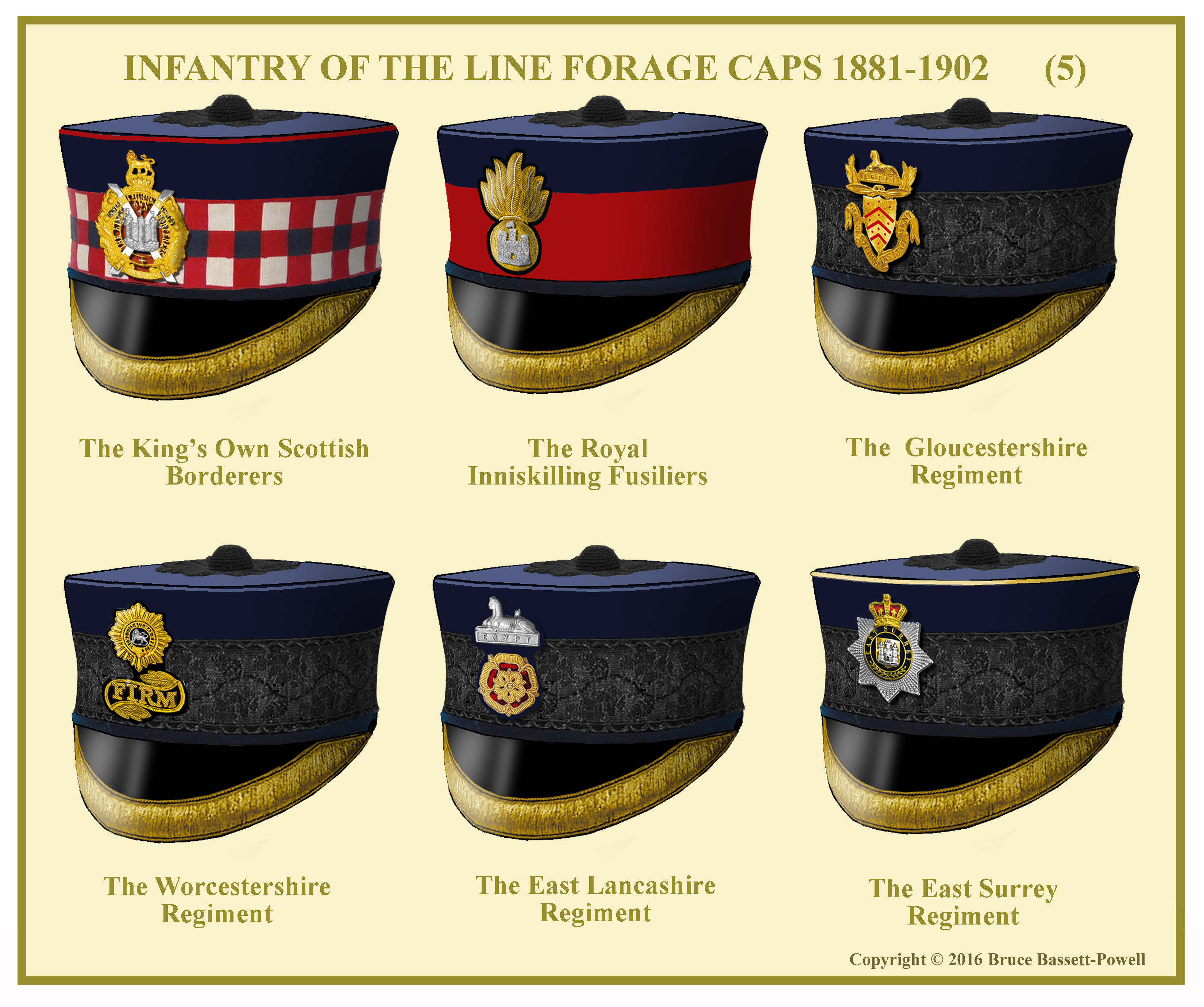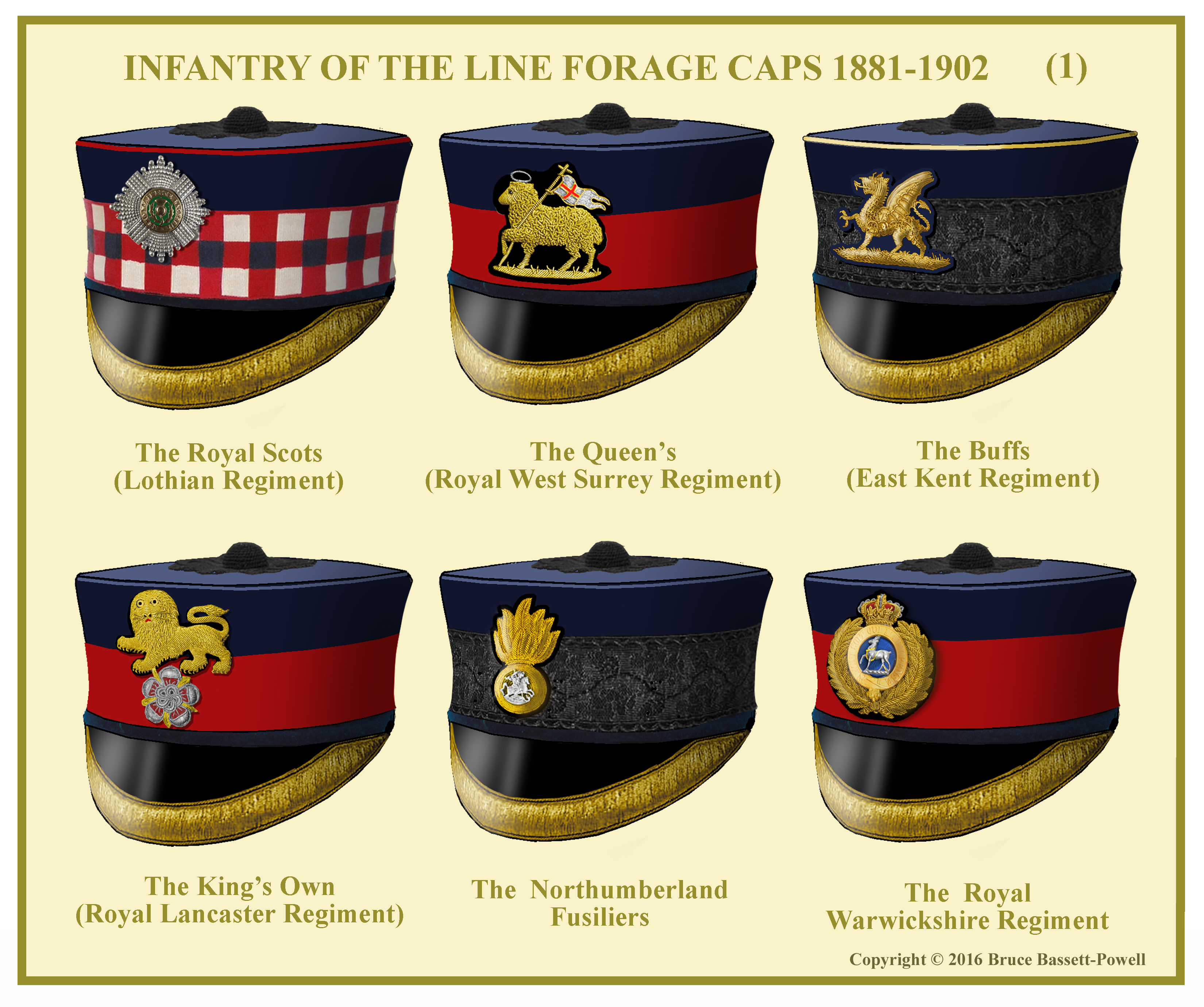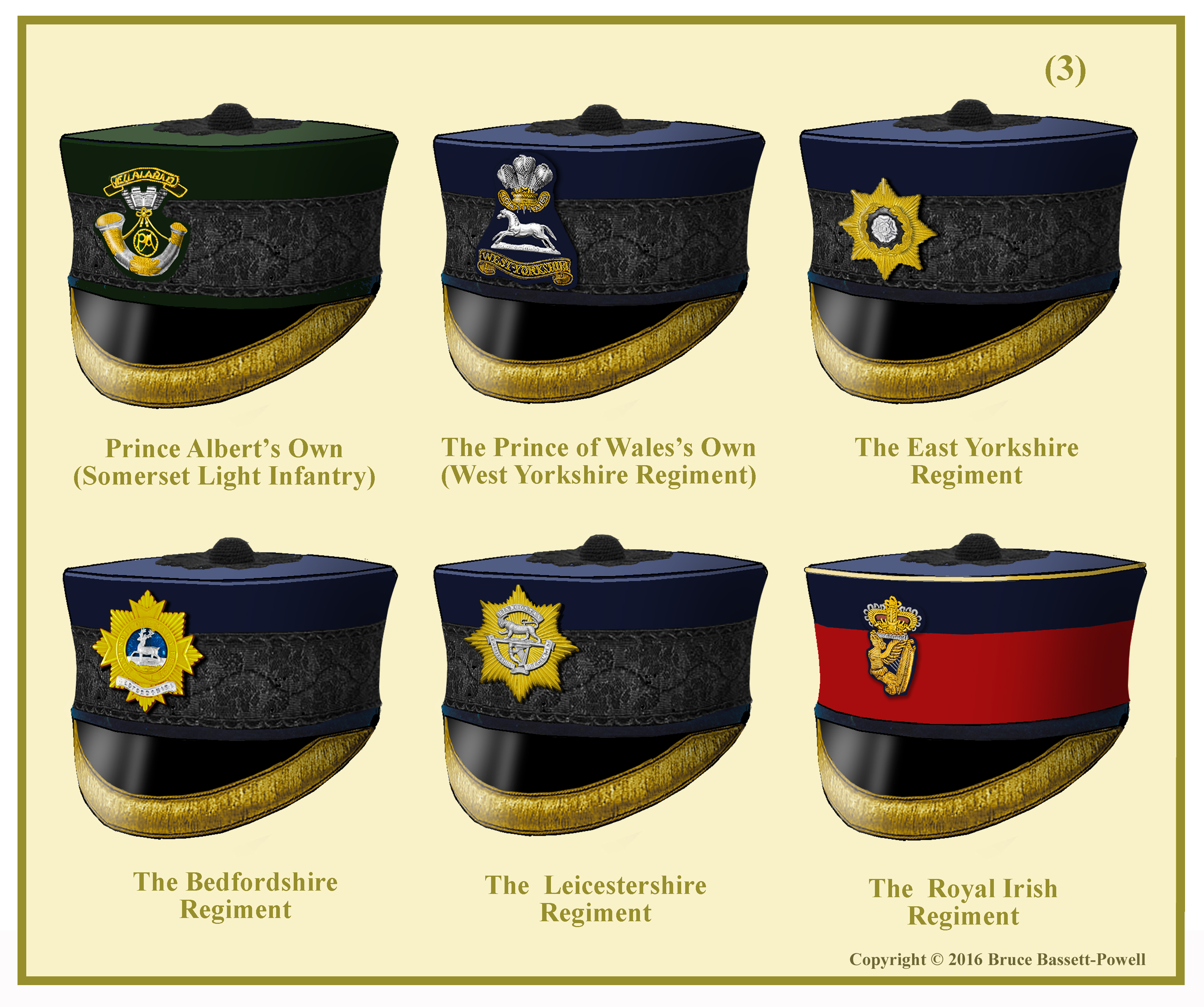INTRODUCTION
The round forage cap with drooping peak, was first introduced generally in 1880 (It had been worn for some time by the Foot Guards – See below) and it was to replace the shallower, kepi style round cap with the flat straight peak that had been worn since just after the Crimean War. At first it had straight sides but after some time, it developed a bell top. The cap was worn by most branches of the army except the cavalry, Royal Artillery and Rifle regiments in the infantry who wore the pillbox cap. On the previous caps, infantry regiments had worn their cap badge which was the regimental number in gilt or brass and where appropriate, a regimental device above. When the Childers reforms of 1881 were enacted, the numbers disappeared and regimental badges were adopted in either embroidery or various metals like gilt or silver. These regimental badges and devices were first described in the Dress Regulations of 1883, and continued through to regulations of 1900. The badges themselves were quite elaborate and must have tested the skill of the embroiderer as it was all done by hand. Because of that, badges varied in detail (sometimes substantially) because the work was done at a different time or by a different firm. Images of these badges have never been completely published before in print or otherwise. Examples exist mostly attached to the caps themselves but we believe that this is the first time the badges of all the regiments that wore them will be shown. The men that wore the caps for over 20 years were very proud of the badges they bore and the loss in 1902 was much lamented.
I would like to acknowledge Bob Bennett of the Victorian Wars Forum, whose brainchild this was and whose meticulous research has made this possible.
THE 1880 FORAGE CAP FOR INFANTRY
The cap was 3 inches high, of blue cloth for infantry and dark green for light infantry. The drooping patent leather peak was edged with a 1/2 inch full gold embroidery. There was a patent leather chinstrap attached inside the headband. Regiments styled ''Royal'' had a band of 1 1/2 inch scarlet cloth while non-Royal regiments and all light infantry regiments had a 1 3/4 inch black band of oak leaf lace. Scottish regiments had bands of red and white diced lace with blue squares for royal regiments and green for non-royal. On the crown of the cap was a netted purl button and braided figure in black lace. On the edge of the crown was a gold Russia braided welt for Field Officers and blue cloth welt for others. Scots (royal) regiments had a scarlet welt. In 1897, all light infantry regiments were ordered to replace the round forage cap with their dark green folding field caps and all Scottish regiments to replace them with the glengarry. It was finally abolished completely in 1902.
WHO WORE THE CAPS?
All the officers of the regiment including the Quartermaster. The Battalion HQ warrant officers and staff sergeants. This included the following appointments; The Sergeant Major, the Bandmaster, the Schoolmaster and the Quarter-Master Sergeant. Also the Musketry Sergeant Instructor, Gymnastics Sergeant Instructor, Band Sergeant, Sergeant Drummer (Later Drum Major), the Armourer Sergeant, Orderly Room Sergeant, Pioneer Sergeant, Signals Sergeant, Hospital Sergeant, Sergeant Master Cook, Sergeant Master Tailor, Sergeant Master Shoemaker.
On a further note: Here is an excerpt from page 140 of the Clothing Regulations 1894 that might be of interest:
9. Cap badges provided at the expense of the soldier under regimental arrangements may be worn as follows: (a) Warrant officers and staff sergeants of Infantry regiments wearing caps with gold embroidered peaks ) A badge as worn by officers of the regiment.
This means that the cost of the badges of all except officers probably came from regimental funds at the Colonel’s discretion.
THE FOOT GUARDS
We begin the series with the Foot Guards. The round cap with drooping peak had been worn by the three regiments since the 1860s so their caps had some significant differences from the line infantry. Firstly there was no netted purl button or braid on the crown. The caps for officers of the Grenadier and Coldstream Guards had a band of black ribbed lace and black patent leather chin straps with gilt buttons on the sides. The RSM, Superintending Clerk, Drill Sergeants and other 1st Class Sergeants had gold bias and stand lace bands and chin straps inside the headbands. In the Scots Guards, the caps were the same for all officers and 1st class sergeants. The cap band was of diced pattern and there was no chin strap. The crown was edged with a gold Russia braid welt.
All bandsmen in the Foot Guards wore the 1st Class Sergeants Forage Cap.
PEAKED FORAGE CAPS AND BADGES IN THE BRITISH ARMY
1881-1902
Description of Badges
THE GRENADIER GUARDS Officers - A gold embroidered grenade worn above the band.
1st Class Sergeants – The grenade in gilt with the Royal monogram in silver embossed on the ball. Worn above the band.
THE COLDSTREAM GUARDS Officers - The Star of the Order of the Garter (The top to bottom dimension was greater than the left to right) worn on the band. 1st Class Sergeants – Star of the order of the Garter in equal dimensions worn above the band.
THE SCOTS GUARDS Officers & 1st Class Sergeants - The Star of the Order of the Thistle worn above the band. The 1st Class Sergeants had a slightly different design of badge.
INFANTRY OF THE LINE
BADGE DESCRIPTIONS
THE ROYAL SCOTS. In silver, the Star of the Order of the Thistle. In gilt metal on the star, a raised circle inscribed Nemo Me Impune Lacessit. Within the circle on a ground of green enamel, the Thistle in gilt metal. (Cap not worn after 1897)
THE QUEEN’S REGIMENT. In gold embroidery on a blue cloth ground, the Paschal Lamb: The flag in silver with a crimson cross.
THE BUFFS. The Dragon in gold embroidery on a blue cloth ground.
THE KING’S OWN. In gold embroidery, the Lion with the Rose of Lancaster below.
THE NORTHUMBERLAND FUSILIERS. A grenade in gold embroidery, with St. George and the Dragon in silver on the ball.
THE ROYAL WARWICKSHIRE REGIMENT. In gilt or gilding metal, the Garter with the motto Honi Soit Que Mal Y Pense, within a wreath of laurel in gold embroidery. The Garter surmounted by the Crown in gold embroidery, with a crimson cap. Within the Garter on a silver blue enamelled ground, the Antelope in silver with gilt collar & chain.
BADGE DESCRIPTIONS
THE ROYAL FUSILIERS (CITY OF LONDON REGIMENT): A grenade in gold embroidery, with a crown on the flame; recessed in the ball, the Garter, pierced with the motto; the ground of blue enamel. The White Rose in silver, in the centre of the Garter.
THE KING’S (LIVERPOOL REGIMENT): In gilt or gilding metal, the Garter pierced with the motto Honi Soit Qui Mal Y Pense; the ground of blue velvet. Within the garter on a crimson velvet raised ground, the White Horse in silver, and a gilt or gilding metal scroll below inscribed “KING’S” in old English capitals.
THE NORFOLK REGIMENT: The figure of Britannia in gold embroidery; the shield embroidered in gold and silk
THE LINCOLNSHIRE REGIMENT: In gilt or gilded metal on a silver eight pointed star; a circle inscribed “Lincolnshire Regiment”. Within the circle on a raised ground of blue velvet, the Sphinx over Egypt in silver.
THE DEVONSHIRE REGIMENT: In gilt or gilding metal, on a bright cut silver eight pointed star, a circle surmounted by the Crown. The circle is pierced with the name “The Devonshire Regiment” on a blue velvet ground. Within, in silver, The Castle of Exeter with the scroll inscribed Semper Fidelis on a ground of blue velvet. The Crown on a crimson velvet cushion.
THE SUFFOLK REGIMENT: In gold embroidery, on a raised blue cloth ground, the Castle and Key within a wreath of laurel: Above the Castle, the Crown; below a scroll in blue velvet inscribed “Gibraltar”. The Crown on a crimson cushion.
BADGE DESCRIPTIONS
THE PRINCE ALBERT’S (SOMERSETSHIRE LIGHT INFANTRY): On a green cloth ground in gold and silver embroidery, a bugle. Within the strings on a convex surface, the cypher of H.R.H. the Late Prince Consort in gilt metal. Above the bugle embroidered in silver, a Mural Crown surmounted by a gold embroidered scroll inscribed “Jellalabad”. The forage cap was not worn by this regiment after 1897. (NOTE: Before 1890 the 1st Battalion had the letters XIII in place of the Prince Consorts cypher). The round forage cap was discontinued in this regiment in 1897
THE PRINCE OF WALES’S OWN (WEST YORKSHIRE REGIMENT): On a blue cloth ground, the White Horse in silver; above, the Prince of Wales’s plume in gold and silver embroidery. Below, a gold embroidered scroll inscribed “West Yorkshire”.
THE EAST YORKSHIRE REGIMENT: A gilt metal on a ground of black enamel, a wreath upon an eight pointed star. Within the wreath, the White Rose in silver.
THE BEDFORDSHIRE REGIMENT: In gilt metal a Maltese cross upon an eight pointed star. On the Cross the Garter with motto; within the garter on a raised ground of blue enamel, a Hart crossing a ford in silver, the ground of the ford in gilt or gilding metal. A silver scroll inscribed “Bedfordshire” below the Garter.
THE LEICESTERSHIRE REGIMENT: An eight pointed star in gilt or gilding metal; On the star the Royal Tiger with the Harp below. Above the Tiger a scroll inscribed “Hindoostan”; below and on either side of the Harp, a scroll inscribed “Leicestershire Regiment”.
THE ROYAL IRISH REGIMENT: The Harp and Crown in gold embroidery on a blue cloth ground. The Crown on a crimson velvet cap.
BADGE DESCRIPTIONS
THE PRINCESS OF WALES’S OWN (YORKSHIRE REGIMENT): On a blue cloth ground, in gold embroidery, the Cypher of H.R.H. the Princess of Wales combined with a cross in silver embroidery edged in crimson. In the centre of the cross, the figures 1875. The whole surmounted by the coronet of the Princess on a cap of crimson velvet.
THE LANCASHIRE FUSILIERS: A grenade in gold embroidery. On the ball, in silver, the Sphinx over EGYPT within a laurel leaf.
THE ROYAL SCOTS FUSILIERS: A grenade in gold embroidery. On the ball, in silver, the Thistle. (The cap was not worn after 1897)
THE CHESHIRE REGIMENT: On a bright cut-silver eight pointed star; a gilt or gilding metal circle with a gilt acorn and oak leaves in the centre on a ground of silver green enamel. On the circle “The Cheshire Regiment”.
THE ROYAL WELSH FUSILIERS: A grenade in gold embroidery. On the ball, in silver, the Red Dragon.
THE SOUTH WALES BORDERERS: In silver within a gilt or gilding metal laurel wreath, the Welsh Dragon on a ground of black velvet. The crown in gilt or gilding metal above the dragon.
BADGE DESCRIPTIONS
THE KING’S OWN SCOTTISH BORDERERS: In gilt metal, a wreath. Within the wreath a circle pierced with the designation “THE KING’S OWN SCOTTISH BORDERERS” Above the circle, a scroll surmounted by the Royal Crest; the scroll pierced with the motto “In Veritate Religionis Confido”. Over the circle, the Cross of St. Andrew in burnished silver. On the cross the Castle of Edinburgh in silver. On the wreath at the bottom a scroll in gilt metal with the motto in relief “Nisi dominus frustra”.
NOTES: In the 1883 Dress Regulations, the designation of the regiment was “KING’S OWN BORDERERS” This was changed to the current one in 1887. (The cap was not worn in this regiment after 1897).
THE ROYAL INNISKILLING FUSILIERS: A grenade in gold embroidery. The castle in silver on the ball.
THE GLOUCESTERSHIRE REGIMENT: In gilt or gilding metal and red enamel, the Arms of the City of Gloucester surmounted by the Sphinx over Egypt on two twigs of laurel. Below the shield, a gilt or gilding metal scroll, inscribed in silver “The Gloucestershire Regiment”.
THE WORCESTERSHIRE REGIMENT: In gold embroidery, an eight pointed star. The Garter in gilt or gilding metal raised on the star and pierced with the motto “Honi Soit Qui Mal Y Pense”. The ground of black velvet. Within the Garter in silver, the Lion pierced on a black velvet ground. Below the star a scroll in gold embroidery inscribed “FIRM”. The ground of blue cloth.
THE EAST LANCASHIRE REGIMENT: In red and gold embroidery, the Rose; above the Rose in silver the Sphinx over Egypt.
THE EAST SURREY REGIMENT: On a bright cut silver eight-pointed star, a raised gilt or gilding metal circle surmounted by the Crown. The circle pierced with the words “East Surrey” with two twigs of laurel in the lower bend: The ground of blue velvet On a ground of blue velvet, the Arms of Guildford in silver on a gilt or gilding metal shield. The cap of the Crown is of crimson velvet.
GO TO PAGE 2

